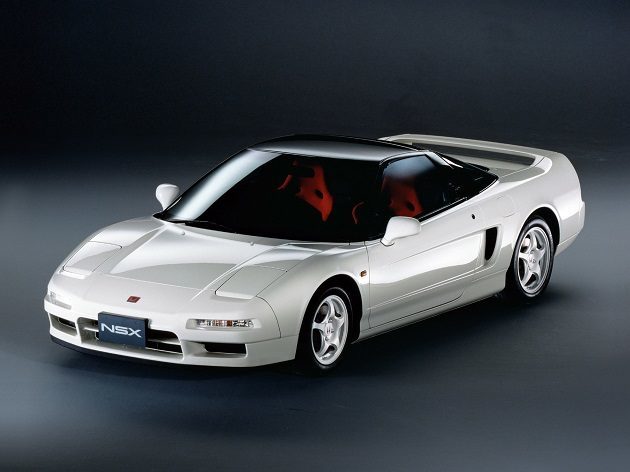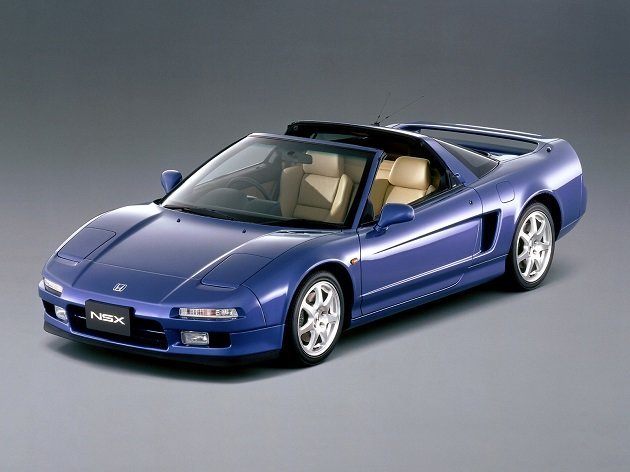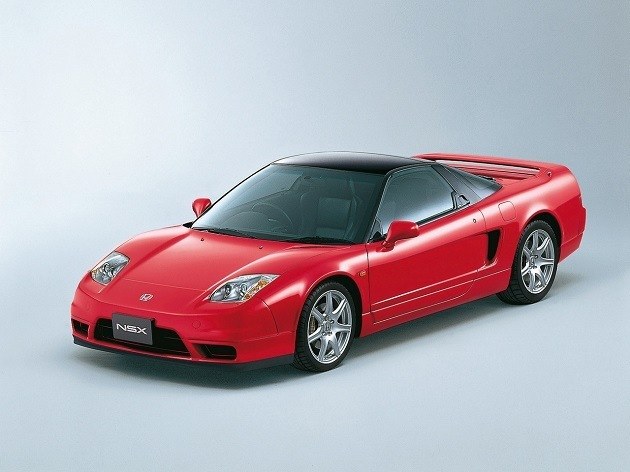Honda NSX (1990 – 2005) Review
Honda NSX (1990 – 2005) At A Glance



The Honda NSX changed the way the world viewed the Japanese motor industry. Alongside the Mazda MX-5 and Lexus LS400, it proved that there were no longer any more areas of the market that the Japanese couldn't attack. the NSX was something rather special, though - a fully-fledged mid-engined junior supercar; a Ferrari 348 rival.
And when the NSX was launched in 1990 it left the competition behind, in terms of reliability and practicality. The chassis was perfected at Suzuka, with late-development input from F1 World Champion Ayrton Senna. Senna convinced Honda to stiffen the NSX even more and totally change the rear suspension geometry to give the NSX uncompromising traction. Even if that would subsequently be proven to be at the cost of tyre wear.
Honda wanted the NSX to be perfect and over its 15-year lifespan it was under constant development. And although it was brilliant, the NSX was slightly too flawed to achieve that perfect ten...
Model History
- March 1989: Honda NS-X revealed in concept form at the Chicago motor show
- August 1989: Journalists drive the first NS-X prototypes
- August 1990: Honda NSX hits the dealers
- November 1992: Honda NSX-R goes on sale
- June 1995: NSX-T launched
- June 1997: Uprated NSX with 3.2-litre engine introduced
- December 2001: Honda NSX given a substantial facelift
- July 2005: Honda announced the death of the NSX
March 1989
Honda NS-X revealed in concept form at the Chicago motor show
August 1989
Journalists drive the first NS-X prototypes
Test drives take place at the Suzuka race track in Japan, and the cars are far from finished. They're powered by tuned C27A engines (as seen in the Honda Legend and Rover 827), and have yet to receive last-minute chassis tuning as suggested by Ayrton Senna.
August 1990
Honda NSX hits the dealers
Note that the hyphen has now been dropped from the name. Groundbreaking features included NSX's ultra-rigid, ultra-light all aluminium monocoque chassis and front and rear double wishbone suspension, with forged control arms connected to forged alloy wheels. Other noteworthy features on Honda's first mid-engined supercar included titanium connecting rods, forged pistons, and an 8000rpm red line, thanks to VTEC-R engine.
The NSX was made at the purpose-built Takanezawa R&D Plant in Tochigi between 1989 and 2004, as well as Suzuka for the final few months.
November 1992
Honda NSX-R goes on sale

This was an NSX specifically modified for track use. The R was lighter, and lost its sound proofing, the in-car entertainment system, spare wheel, air conditioning and traction control. Carbonfibre seats were fitted, as well as light weight forged aluminium wheels by Enkei - overall weight was now 1230kg (down from 1350). 483 were built - all sold in Japan, but many subsequently exported.
June 1995
NSX-T launched

Targa-topped NSX unveiled, and sold to special order only. The car was 45kg heavier than standard and was less stiff structurally, meaning the suspension was tweaked slightly to compensate.
June 1997
Uprated NSX with 3.2-litre engine introduced

NSX received the revised C32B engine, which upped power from 276 to 290bhp - torque was also improved to 225lb ft from 210. The four-speed automatic version remained unchanged. Six-speed manual transmission also introduced, optimising in-gear and outright acceleration - 0-60mph acceleration improved to 4.7 seconds.
In Japan, the NSX Type-S was launched to sell alongside the standard model. It was stiffer and lighter than the standard NSX, and like the previous Type-R was stripped of much of its luxury equipment.
December 2001
Honda NSX given a substantial facelift

The original NSX was tweaked for 2002 - with the main change being limited to the dropping of the pop-up headlamps, to be replaced by flush-fitting Xenon units. The suspension set-up was revised, and larger wheels were fitted, improving grip levels, if not comfort, significantly.
July 2005
Honda announced the death of the NSX
With sales drying up, Honda took the decison to stop the NSX without a replacement in sight. Although the company had been investigating a 'new' NSX since the turn of the century, no production models resulted. In July 2005, Honda officially announced that it would cease manufacturing NSX after 15 years, and it wouldn't be until the Geneva show of 2013 that the company confirmed that its replacement - a hybrid mid-engined supercar - also called the NSX, would go into production in 2015, some 25 years after the launch of the original.
Driving Honda NSX (1990 – 2005)
Being a car manufacturer obsessed by engineering, it's no surprise to learn that the NSX's engineering make-up is both pure and esoteric. Not just in terms of how the car was designed, but Honda's single-mindedness in building the ultimate supercar is evident in the materials used, and how they're employed. But when creating the NSX, Honda ensure that reliability consistent with every other model in the range (so, completely dependable), and not at all intimidting for anyone to drive. And in 1990, this was an utterly unique blend of abilities.
Today, this is evident in the cult fillowing the NSX has picked up along the way. And boy, is it deserved. The engine is a masterpiece - for a power unit designed in the middle of F1's turbo era, it was unusual that Honda decided to keep it naturally aspirated. But, for the purest throttle response and cleanest power delivery, this would be essential. The all-aluminium power has a specification sheet that reads well today: 24-valves, four cams and VTEC variable valve timing for 270bhp at 7300rpm.
During development, the engineering team enlisted McLaren driver, Ayrton Senna to offer some much appreciated dynamic input. He was a Suzuka regular, and so when a McLaren testing session coincided with one of Honda’s in February ’89 the road car engineers were keen to get him behind the wheel and see what he thought. After a few laps in the 250bhp Legend-engined prototype, he came back with the feedback: ‘I'm not sure I can really give you appropriate advice on a mass-production car, but I feel it’s a little fragile.’
He felt the torsional rigidity of the body wasn’t good enough, and although Honda had built a shell as stiff as Ferrari and Porsche’s Senna thought it needed beefing-up. Honda re-engineered the hull, making it 50% stiffer, and then asked him back to dial-in chassis improvements in the run-up to full production - which he duly did. And after driving the NSX at length in the UK, you'll be appreciative of Senna's input, even if it's saddled the NSX with a voracious appetite for tyres.
Even before you're away, you'll love its interior. The driver's seat is low-slung, and the visibility is excellent for a mid-engined supercar. Although the dash and centre console swoop around and envelop you, the controls are logically and predictably placed, and the switchgear is just as well-engineered as any other Honda from this era. Some might say it lacks an element of 'specialness' that marks out a Lamborghini or Ferrari of this age, but we can't pretend that its user friendliness isn't welcome.
Firing up the quad-cam 24-valve VTEC V6 engine is no disappointment. It barks into life and settles into an even, sharp-edged idle. At low revs it all sounds a bit ordinary, though. The test car, owned by Honda UK, is a four-speed automatic, which means a softer throttle map and less power - and putting the NSX into Drive and heading off, leaves you feeling a bit underwhelmed.
But like some of the best performance cars ever built, this veneer of civility is soon shed once out of the the urban sprawl. The ultra precise steering, with variable power assistance, is full of feel, and stringing together a series of corners smoothly is seriously easy. The suspension set-up is briliant, with almost no body roll, and placing the NSX in any corner is simple due to how accurate and full of feel the steering is. Just as Honda promised, the NSX makes a hero out of an average driver.
Acceleration feels disappointing in Drive – the gearing is long, and although it was a state-of-the-art self-shifter in 1989 there’s still laziness and lag to contend with. The change-up points on the retuned-for-auto engine are also on the low side – the VTEC engine really sings from 5500rpm, but keep your foot to the floor and it’s wanting to select the next gear just after 6000rpm; and that’s right in the heart of the power band.
It's best to change-up manually, and hit the 7500rpm limiter. If you adopt this approach, you’ll experience a tingling, hard-edged V6 that wails like a racing car in full flight. It’s a cross between 911 and Dino Ferrari, but smoothed-out and refined - and it's utterly soulful. This is not the sanitised effort that those who don't 'get' Japanese cars might tell you it's going to be.
Combine the brilliant VTEC-R engine with a Senna-tweaked chassis of rare ability, and you're left with a car that is capable of remarkable performance. Point to point, there would be few cars of this era capable of touching an NSX, even in the hands of an average driver.
Honda NSX (1990 – 2005) Buying Guide
Good
- Surprisingly civilised supercar.
- 14' 7" long by 6' wide and weighing 1,410kg.
- As easy to drive as a Honda Civic, but originally had storming VTEC V6 with 271 bhp that sounds wonderful.
- Early 5-speed models did not have standard PAS and were better for it (optional PAS was electric). Aircon standard, naturally. Auto optional.
- Targa came along in July '95 with standard PAS and optional F-Matic auto or six-speed manual.
- Engine grew to 3,179cc in Feb 1998 giving 276hp and more torque. Far more reliable and easy to live with on a day-to-day basis than a Ferrari. Revamped again for 2002: 276b, 220lb ft torque; top speed 168mph; 0-60 in 5.5 seconds; combined economy 22.8mpg.
- In June 2001 Honda was rated by Motor Warranty Direct as Britain's 4th most claim-free used marque. Hondas generally 8th lowest average warranty repair costs in 2003 Warranty Direct Reliability index (index 67.27 v/s lowest 31.93) www.reliabilityindex.co.uk/default.html?apc=311
Bad
- Tends to understeer quite a lot rather than catch you out with snap-oversteer.
- Power-steered cars lack steering feel.
- Eats rear tyres (6,000-8,000 miles), which were originally very expensive, but price of these has now come down.
Watch
- Must have full dealer service history with super-clean fully synthetic oil, frequent ATF, brake fluid, coolant, aircon refrigerant changes.
- Check carefully for any signs of uneven tyre wear.
- Alloy suspension is vulnerable to off road (or off track) excursions and speed hump and pot hole damage.
Recalls
- All official Honda recalls: www.honda.co.uk/cars/owners/youandyourcar/recallsandupdates
Running Honda NSX (1990 – 2005)

.jpg?width=640&height=426&rmode=crop)
.jpg?width=640&height=426&rmode=crop)
.jpg?width=640&height=426&rmode=crop)
.jpg?width=640&height=426&rmode=crop)
.jpg?width=640&height=426&rmode=crop)
.jpg?width=640&height=426&rmode=crop)